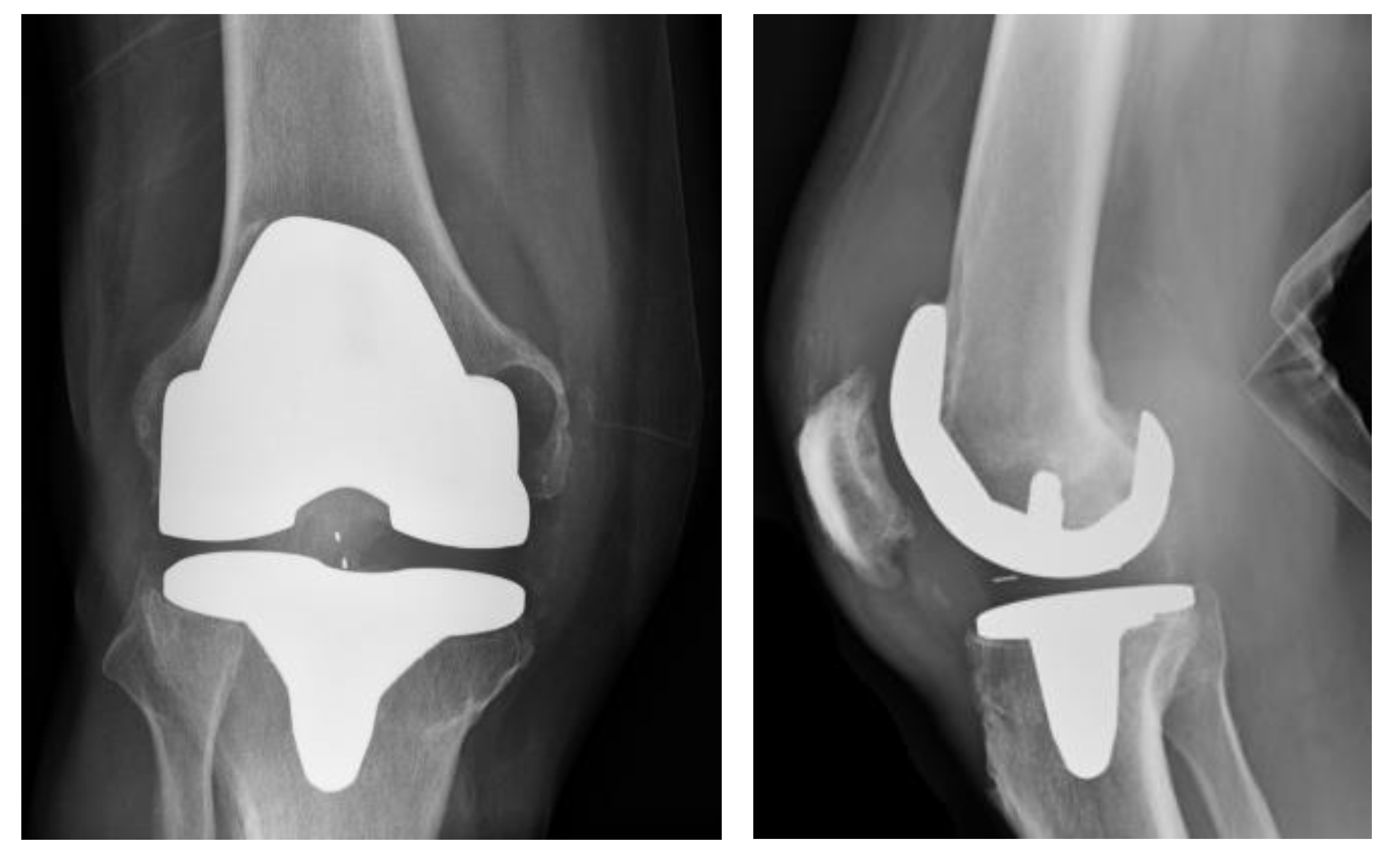Revision Total Knee Arthroplasty Utilizing Threaded Pins in Cement for Tibial Bone Loss
Abstract
:1. Introduction
2. Case Description
3. Discussion
4. Conclusions
Author Contributions
Funding
Institutional Review Board Statement
Informed Consent Statement
Data Availability Statement
Conflicts of Interest
References
- Cinotti, G.; Ripani, F.R.; Ciolli, G.; La Torre, G.; Giannicola, G. The native coronal orientation of tibial plateaus may limit the indications to perform a kinematic aligned total knee arthroplasty. Knee Surg. Sports Traumatol. Arthrosc. 2019, 27, 1442–1449. [Google Scholar] [CrossRef] [PubMed]
- Rivière, C.; Iranpour, F.; Auvinet, E.; Howell, S.; Vendittoli, P.-A.; Cobb, J.; Parratte, S. Alignment options for total knee arthroplasty: A systematic review. Orthop. Traumatol. Surg. Res. 2017, 103, 1047–1056. [Google Scholar] [CrossRef] [PubMed]
- Myers, G.J.C.; Abudu, A.T.; Carter, S.R.; Tillman, R.M.; Grimer, R.J. The long-term results of endoprosthetic replacement of the proximal tibia for bone tumours. J. Bone Jt. Surg Br. 2007, 89, 1632–1637. [Google Scholar] [CrossRef] [PubMed]
- Kostuj, T.; Streit, R.; Baums, M.H.; Schaper, K.; Meurer, A. Midterm Outcome after Mega-Prosthesis Implanted in Patients with Bony Defects in Cases of Revision Compared to Patients with Malignant Tumors. J. Arthroplast. 2015, 30, 1592–1596. [Google Scholar] [CrossRef]
- Shehadeh, A.; Noveau, J.; Malawer, M.; Henshaw, R. Late complications and survival of endoprosthetic reconstruction after resection of bone tumors. Clin. Orthop. Relat. Res. 2010, 468, 2885–2895. [Google Scholar] [CrossRef] [Green Version]
- Brooks, P.J.; Walker, P.S.; Scott, R.D. Tibial component fixation in deficient tibial bone stock. Clin. Orthop. Relat. Res. 1984, 184, 302–308. [Google Scholar] [CrossRef]
- Bilgen, M.S.; Eken, G.; Guney, N. Short-term results of the management of severe bone defects in primary TKA with cement and K-wires. Acta Orthop. Traumatol. Turc. 2017, 51, 388–392. [Google Scholar] [CrossRef] [PubMed]
- Sculco, P.K.; Abdel, M.P.; Hanssen, A.D.; Lewallen, D.G. The management of bone loss in revision total knee arthroplasty. Bone Jt. J. 2016, 98 (Suppl. A), 120–124. [Google Scholar] [CrossRef] [PubMed]
- Ghazavi, M.T.; Stockley, I.; Yee, G.; Davis, A.; Gross, A.E. Reconstruction of massive bone defects with allograft in revision total knee arthroplasty. J. Bone Jt. Surg Am. 1997, 79, 17–25. [Google Scholar] [CrossRef]
- Xie, S.; Conlisk, N.; Hamilton, D.; Scott, C.; Burnett, R.; Pankaj, P. Metaphyseal cones in revision total knee arthroplasty: The role of stems. Bone Jt. Res. 2020, 9, 162–172. [Google Scholar] [CrossRef] [PubMed]
- Dorr, L.D.; Ranawat, C.S.; Sculco, T.A.; McKaskill, B.; Orisek, B.S. Bone graft for tibial defects in total knee arthroplasty. Clin. Orthop. Relat. Res. 1986, 205, 153–165. [Google Scholar] [CrossRef]
- Qiu, Y.Y.; Yan, C.H.; Chiu, K.Y.; Ng, F.Y. Review article: Treatments for bone loss in revision total knee arthroplasty. J. Orthop. Surg. 2012, 20, 78–86. [Google Scholar] [CrossRef] [PubMed] [Green Version]
- Cuckler, J. Bone loss in total knee arthroplasty: Graft augment and options. J. Arthroplast. 2004, 19, 56–58. [Google Scholar] [CrossRef] [PubMed]
- Pala, E.; Trovarelli, G.; Calabrò, T.; Angelini, A.; Abati, C.N.; Ruggieri, P. Survival of modern knee tumor megaprostheses: Failures, functional results, and a comparative statistical analysis. Clin. Orthop. Relat. Res. 2015, 473, 891–899. [Google Scholar] [CrossRef] [PubMed]





Disclaimer/Publisher’s Note: The statements, opinions and data contained in all publications are solely those of the individual author(s) and contributor(s) and not of MDPI and/or the editor(s). MDPI and/or the editor(s) disclaim responsibility for any injury to people or property resulting from any ideas, methods, instructions or products referred to in the content. |
© 2023 by the authors. Licensee MDPI, Basel, Switzerland. This article is an open access article distributed under the terms and conditions of the Creative Commons Attribution (CC BY) license (https://creativecommons.org/licenses/by/4.0/).
Share and Cite
Jiganti, M.; Tedesco, N. Revision Total Knee Arthroplasty Utilizing Threaded Pins in Cement for Tibial Bone Loss. Medicina 2023, 59, 162. https://doi.org/10.3390/medicina59010162
Jiganti M, Tedesco N. Revision Total Knee Arthroplasty Utilizing Threaded Pins in Cement for Tibial Bone Loss. Medicina. 2023; 59(1):162. https://doi.org/10.3390/medicina59010162
Chicago/Turabian StyleJiganti, Max, and Nicholas Tedesco. 2023. "Revision Total Knee Arthroplasty Utilizing Threaded Pins in Cement for Tibial Bone Loss" Medicina 59, no. 1: 162. https://doi.org/10.3390/medicina59010162




